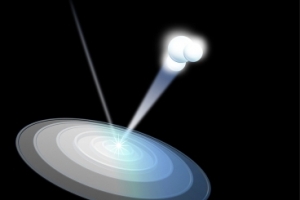Consider the nearest water surface: a half-full glass on your desk, a puddle outside your window, or a lake across town. All of these surfaces represent liquid-vapor interfaces, where liquid meets air. Molecules of water vapor constantly collide with these liquid surfaces: Some make it through the surface and condense, while others simply bounce off.
 A water molecule bounces off a liquid surface from the vapor phase.Graphic: Yukiko Oka
A water molecule bounces off a liquid surface from the vapor phase.Graphic: Yukiko Oka
The probability that a vapor molecule will bounce, or reflect, off a liquid surface is a fundamental property of water, much like its boiling point. And yet, in the last century, there has been little agreement on the likelihood that a water molecule will bounce off the liquid surface.
"When a water vapor molecule hits a surface, does it immediately go into the liquid? Or does it come off and hit again and again, then eventually go in?" says Rohit Karnik, an associate professor of mechanical engineering at MIT. "There's a lot of controversy, and there's no easy way to measure this basic property."
Knowing this bouncing probability would give scientists an essential understanding of a variety of applications that involve water flow: the movement of water through soil, the formation of clouds and fog, and the efficiency of water-filtration devices.
This last application spurred Karnik and his colleagues — Jongho Lee, an MIT graduate student in mechanical engineering, and Tahar Laoui, a professor at the King Fahd University of Petroleum and Minerals (KFUPM) in Saudi Arabia — to study water's probability of bouncing. The group is developing membranes for water desalination; this technology's success depends, in part, on the ability of water vapor to flow through the membrane and condense on the other side as purified water.
By observing water transport through membranes with pores of various sizes, the group has measured a water molecule's probability of condensing or bouncing off a liquid surface at the nanoscale. The results, published in Nature Nanotechnology, could help in designing more efficient desalination membranes, and may also expand scientists' understanding of the flow of water at the nanoscale.
"Wherever you have a liquid-vapor surface, there is going to be evaporation and condensation," Karnik says. "So this probability is pretty universal, as it defines what water molecules do at all such surfaces."
Getting in the way of flow
One of the simplest ways to remove salt from water is by boiling and evaporating the water — separating it from salts, then condensing it as purified water. But this method is energy-intensive, requiring a great deal of heat.
Karnik's group developed a desalination membrane that mimics the boiling process, but without the need for heat. The razor-thin membrane contains nanoscale pores that, seen from the side, resemble tiny tubes. Half of each tube is hydrophilic, or water-attracting, while the other half is hydrophobic, or water-repellant.
As water flows from the hydrophilic to the hydrophobic side, it turns from liquid to vapor at the liquid-vapor interface, simulating water's transition during the boiling process. Vapor molecules that travel to the liquid solution on the other end of the nanopore can either condense into it or bounce off of it. The membrane allows higher water-flow rates if more molecules condense, rather than bounce.
Designing an efficient desalination membrane requires an understanding of what might keep water from flowing through it. In the case of the researchers' membrane, they found that resistance to water flow came from two factors: the length of the nanopores in the membrane and the probability that a molecule would bounce, rather than condense.
In experiments with membranes whose nanopores varied in length, the team observed that greater pore length was the main factor impeding water flow — that is, the greater the distance a molecule has to travel, the less likely it is to traverse the membrane. As pores get shorter, bringing the two liquid solutions closer together, this effect subsides, and water molecules stand a better chance of getting through.
But at a certain length, the researchers found that resistance to water flow comes primarily from a molecule's probability of bouncing. In other words, in very short pores, the flow of water is constrained by the chance of water molecules bouncing off the liquid surface, rather than their traveling across the nanopores. When the researchers quantified this effect, they found that only 20 to 30 percent of water vapor molecules hitting the liquid surface actually condense, with the majority bouncing away.
A no-bounce design
They also found that a molecule's bouncing probability depends on temperature: 64 percent of molecules will bounce at 90 degrees Fahrenheit, while 82 percent of molecules will bounce at 140 degrees. The group charted water's probability of bouncing in relation to temperature, producing a graph that Karnik says researchers can refer to in computing nanoscale flows in many systems.
"This probability tells us how different pore structures will perform in terms of flux," Karnik says. "How short do we have to make the pore and what flow rates will we get? This parameter directly impacts the design considerations of our filtration membrane."
Lee says that knowing the bouncing probability of water may also help control moisture levels in fuel cells.
"One of the problems with proton exchange membrane fuel cells is, after hydrogen and oxygen react, water is generated. But if you have poor control of the flow of water, you'll flood the fuel cell itself," Lee says. "That kind of fuel cell involves nanoscale membranes and structures. If you understand the correct behavior of water condensation or evaporation at the nanoscale, you can control the humidity of the fuel cell and maintain good performance all the time."